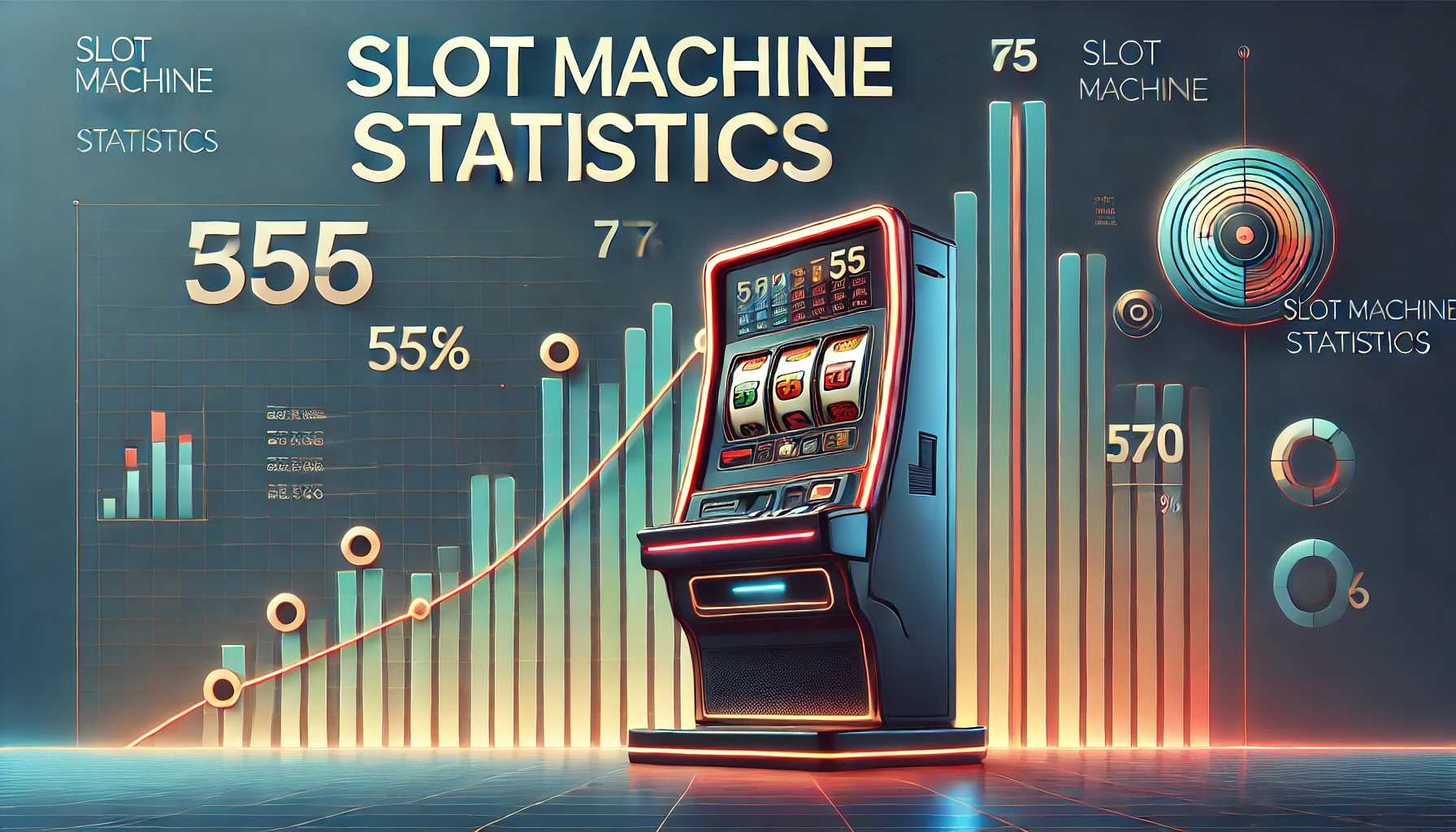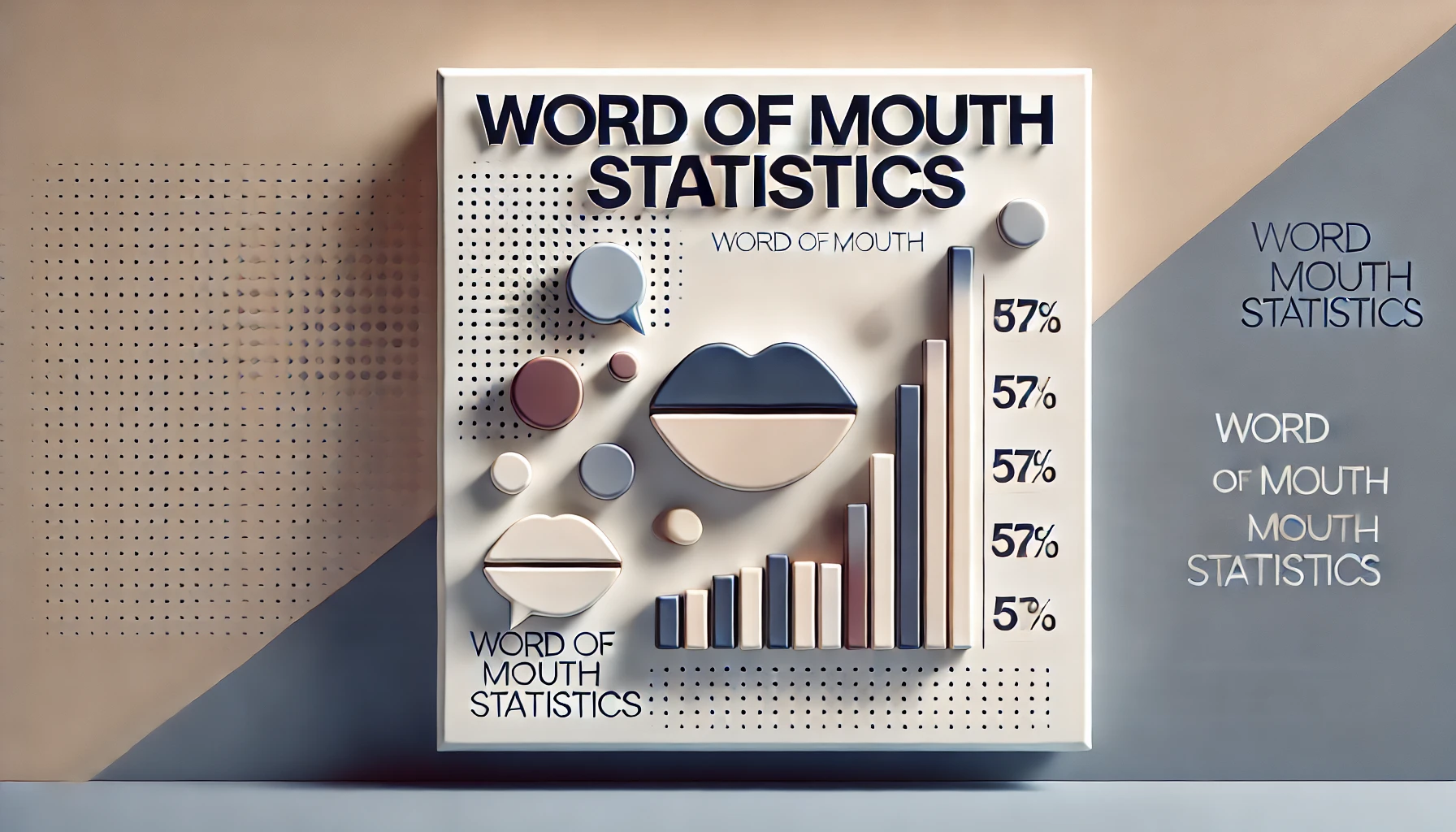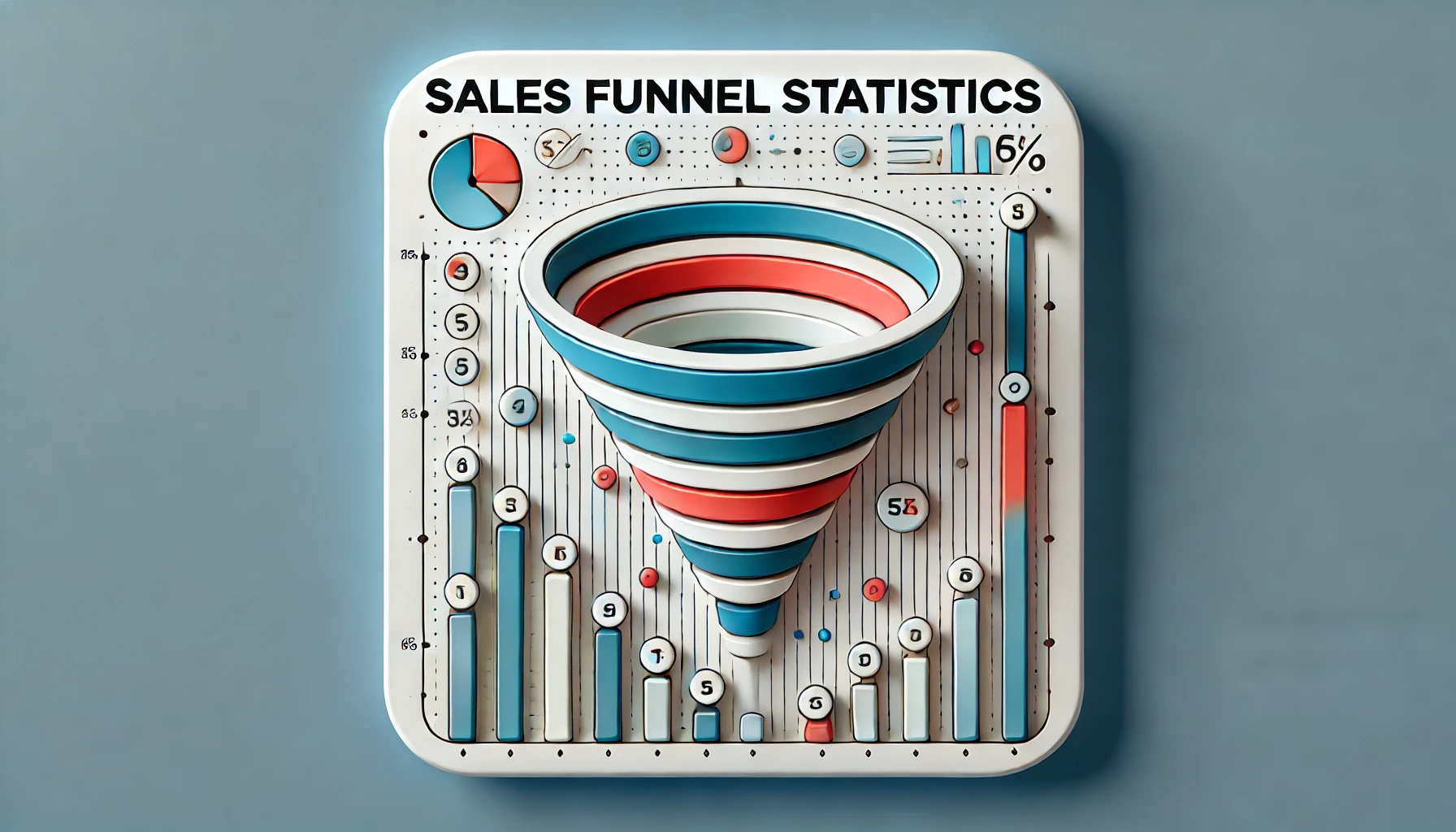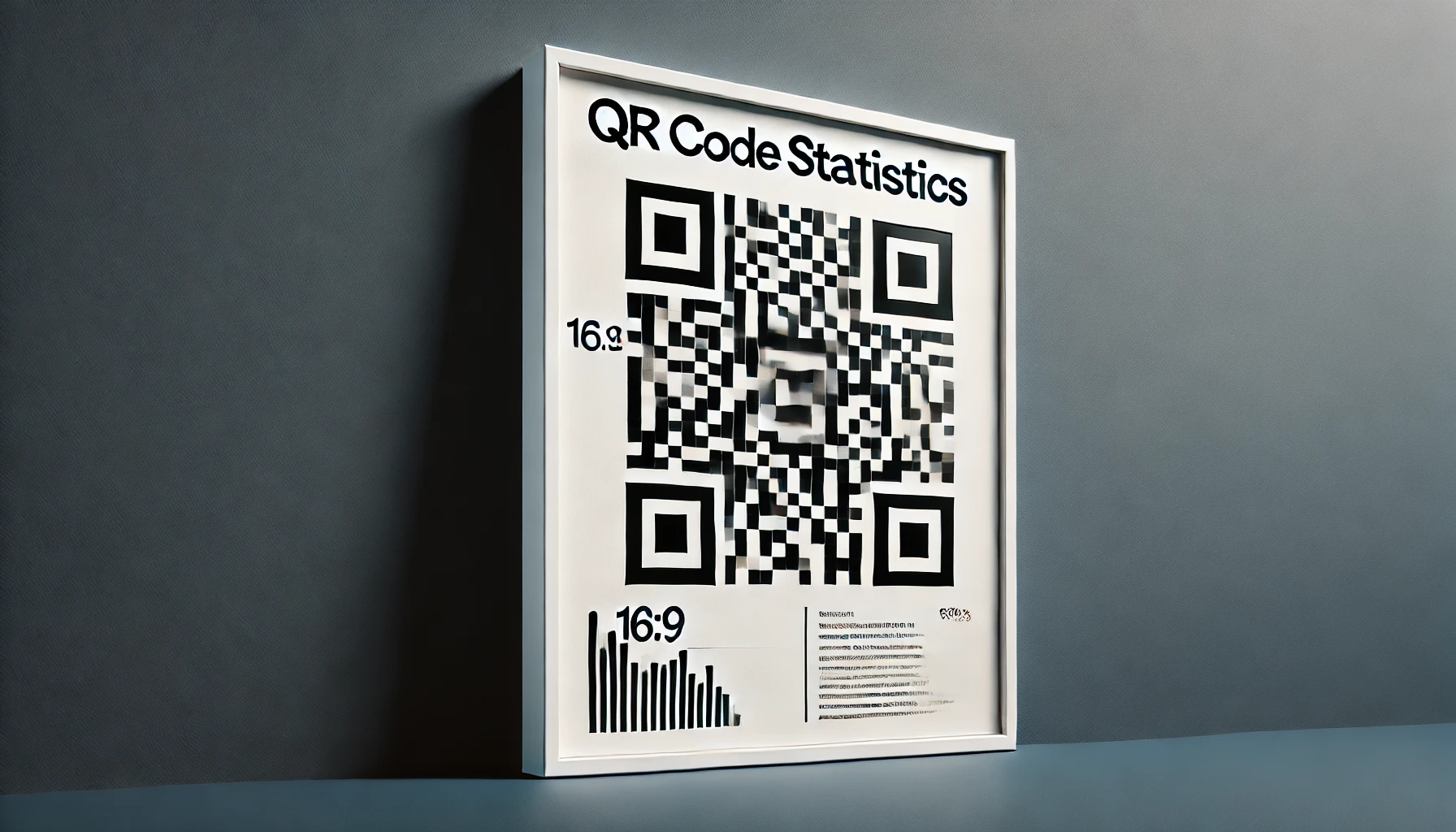Bubble Tea Popularity Statistics By Origin, Development, Region, Segment, Demographics, Market And Trends
Updated · Oct 08, 2024
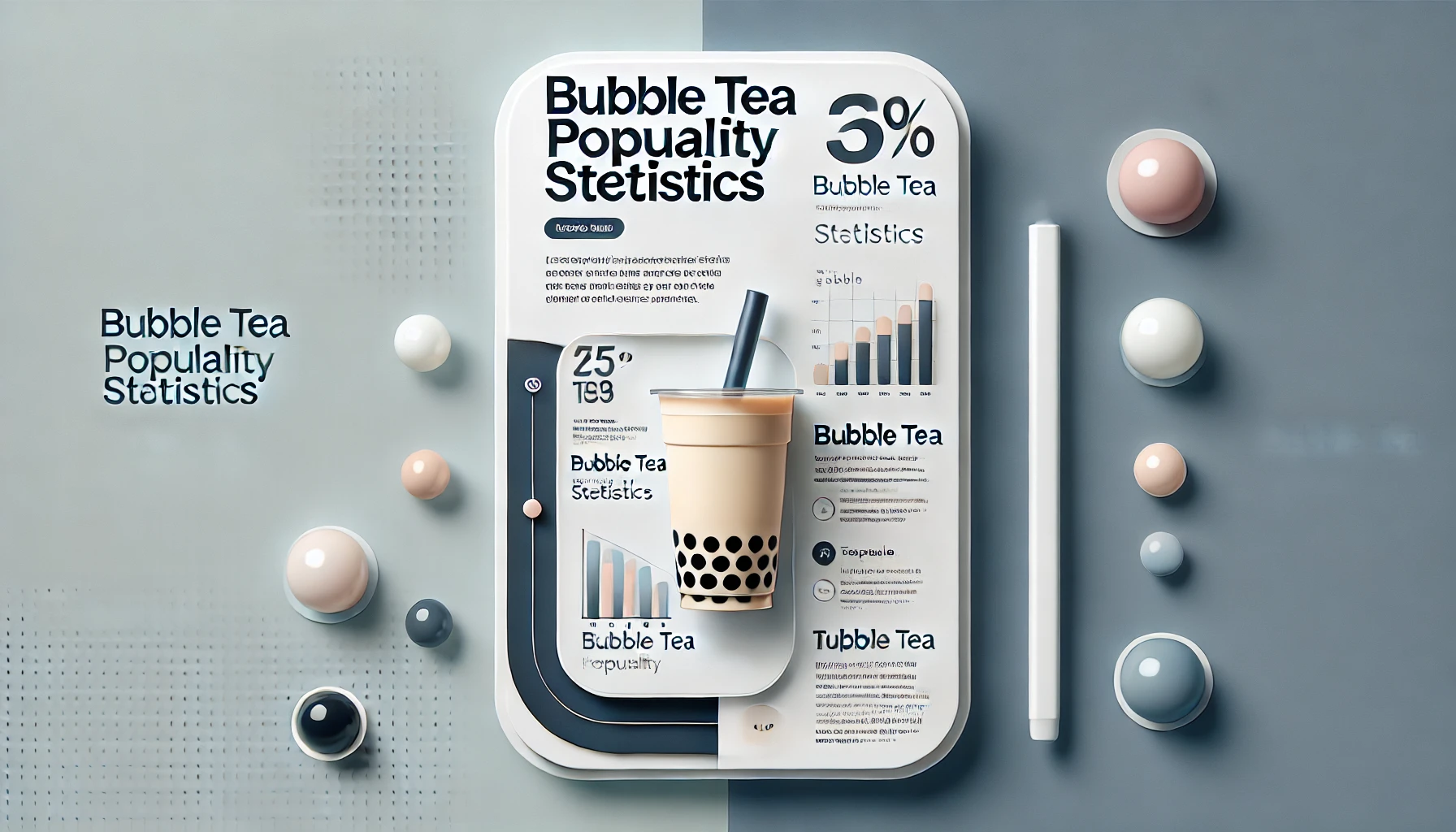
WHAT WE HAVE ON THIS PAGE
- Introduction
- Editor’s Choice
- What is Bubble Tea?
- What Are Bubbles?
- Bubble Tea Origins And History
- General Bubble Tea Popularity Statistics
- Nutrition Value Of Bubble Tea
- Recent Development In The Bubble Tea Market
- How is Bubble Tea Made?
- Consumer Preferences And Trends Of Bubble Tea
- Emerging Market and Trends
- Bubble Tea Regional Insight
- Segmentation Analysis Statistics
- Consumer Demographics Statistics
- Conclusion
Introduction
Bubble Tea Popularity Statistics: Since it began in Taiwan, bubble tea has quickly become one of the most Instagram-friendly drinks in the world. Its popularity shows no signs of slowing down. The global bubble tea market is predicted to increase by $1,226.22 million from 2023 to 2027.
This growth is linked to three other trends: more people are choosing low and no-alcohol drinks, focusing on health, and enjoying caffeinated beverages more. In this article, we’ll discuss why Bubble Tea Popularity Statistics are a hit with both sellers and customers and how you can make the most of this trend in your business.
Editor’s Choice
- The bubble tea market is growing steadily, with a compound annual growth rate (CAGR) of 8.69% during the forecast period.
- The market was estimated to be about $2.89 billion in 2023 and is expected to reach around $6.12 billion by 2032.
- According to the Bubble Tea Popularity Statistics, this market is expanding rapidly in many regions due to cultural tastes, new and exciting flavors, and a rising focus on health.
- The black tea segment is experiencing fast growth and is likely to be the leader in the market.
- The flavor segment is expected to hold the largest share of the market.
- Bubble Tea Popularity Statistics state that fruit flavors are predicted to be the most popular among consumers.
- The Asia Pacific region is growing quickly and is projected to be the largest market.
- The global bubble tea market was valued at $2.02 billion in 2019.
- It is expected to grow to $4.3 billion by 2027.
- The market is projected to increase at a compound annual growth rate (CAGR) of 8.1% from 2020 to 2027.
- The global bubble tea market is also expected to see a CAGR of 7.2% during the same period.
- In Europe, the bubble tea market is growing rapidly, with more bubble tea cafes opening in major cities.
- As of 2023, the bubble tea industry in the United States is worth $2.4 billion. In 2020, Taiwan had over 15,000 bubble tea shops, making it the place with the most shops in the world.
- The first bubble tea shop outside of Asia opened in Portland, Oregon, in 1993. In 2019, the global bubble tea market was valued at $2.4 billion.
- In China, the bubble tea market is valued at more than $10 billion.
- As of 2021, South Korea had over 10,000 bubble tea shops. In Singapore, the bubble tea market was nearly $40 million.
What is Bubble Tea?
Boba tea is made from tea, water, sugar, milk, and tapioca pearls. The sweet iced tea is shaken like a cocktail before adding the tapioca pearls. Common types of tea used are green, black, or oolong, but there are now many Flavors, including mocha and fruit milk. The pearls could be white, black, or flavored. Many bubble tea is creamy and sweet, with milk options ranging from whole to non-fat, coconut, or almond. Some fruit versions might still need milk or tea.
Popping boba is a newer kind made from fruit juice, water, agar-agar (a seaweed extract) or calcium compounds, and sweetener. These pearls burst with fruit juice when you bite them and are often found in fruit-related boba teas.
The tapioca pearls are what make boba tea unique. They sit on the downside of the cup and have a chewy texture that many people enjoy. These pearls are made from cassava starch mixed with hot water, rolled into balls, and cooked in brown sugar syrup for the black color or plain syrup for white or flavored pearls, giving them a slight sweetness.
Other ingredients can involve aloe, coffee jelly, taro or sweet potato balls, grass jelly, fresh fruit, or red beans.
What Are Bubbles?
Bubble tea, also known as boba, is a fun drink from Taiwan that is made by mixing tea with milk, fruit, and fruit juices. It is topped with chewy tapioca pearls, which add a unique texture, making bubble tea both a drink and a snack.
Served in clear cups with wide straws, bubble tea is versatile. It can be enjoyed hot or cold. The name “bubble tea” comes from the tapioca pearls and the bubbles that form when the drink is shaken.
Bubble tea’s bright colors and interesting look have made it popular on social media, with influencers sharing pictures of their creative flavors and cool drinks. Whether you choose classic milk tea or a fruity option, bubble tea brings a fun twist to your beverage choices!
Bubble Tea Origins And History
- Bubble tea was invented in Taiwan in the 1980s and is known by various names around the world, such as pearl milk tea, boba tea, and tapioca tea.
- It’s usually served with a wide straw, allowing customers to enjoy both the tea and the chewy tapioca pearls. Traditional recipes typically include black tea, milk, sugar, and tapioca pearls.
- Bubble tea is highly customizable so that customers can choose their favorite tea base, sweetness level, and toppings, as per Bubble Tea Popularity Statistics.
- The tapioca pearls, made from cassava roots, come in different sizes and colors.
- The name “bubble tea” comes from the frothy bubbles that form on top when the tea is shaken or blended. Some variations use different bases, such as fruit teas, flavored syrups, or non-dairy milk.
- Bubble tea can be served hot or cold, depending on the customer’s preference and the shop’s recipe.
- The chewy form is generated from tapioca pearls, which are made and soaked in sweet syrup way before being added to the drink.
- In the US, especially on the West Coast, bubble tea is often called “boba.” It has a wide range of flavors, including traditional choices like jasmine tea and trendy options like brown sugar milk tea.
General Bubble Tea Popularity Statistics
- The bubble tea market is expected to grow to $125.2 billion by 2026.
- Bubble tea is the 4th most popular tea drink in the world.
- The global bubble tea market is projected to increase at a rate of 7.6% per year from 2021 to 2028.
- In the last five years, bubble tea sales in the United States have jumped by 300%.
- In 2020, the global bubble tea market was valued at $2.9 billion.
- The Asia Pacific region has the largest share of the global bubble tea market.
- Millennials and Gen Z consumers especially favor bubble tea.
- By 2027, the global bubble tea market is estimated to reach 8.4 billion servings.
- Bubble Tea Popularity Statistics state that Taiwan is recognized as the birthplace of bubble tea.
- The most popular bubble tea flavors worldwide are taro, matcha, and classic milk tea.
- On average, a bubble tea shop sells over 100 cups each day.
- The bubble tea market in North America is expected to see significant growth due to increased consumer awareness.
- The bubble tea industry in the United States is valued at $2 billion.
- The most common topping for bubble tea is tapioca pearls.
- The bubble tea market in Europe is projected to grow at a rate of 8.3% per year from 2021 to 2027.
- A large study of bubble tea sellers around the world found more than 250 different flavors available. This variety is greater than that of any other drink except for flavored coffee.
- Basic bubble tea usually costs between $3 and $5, as per Bubble Tea Popularity Statistics.
- For people thinking about starting a bubble tea business, knowing the profit margins is key. A standard (small) bubble tea generally costs between $3 and $5.
- When customers add toppings and extras, the price can go up to around $10 to $12. Despite this, market growth shows that bubble tea lovers are willing to pay these prices.
Nutrition Value Of Bubble Tea
- Bubble tea, also known as boba tea, comes in many different types, so its nutritional value can change. While we’ve talked about milk tea, boba drinks often have additional ingredients.
- The boba pearls are usually made from tapioca starch, which is derived from the cassava plant.
- Sometimes, other ingredients are added to give the pearls various colors, flavors, or sweetness.
- A 10-gram serving of plain tapioca pearls has around 35 calories and 9 grams of carbs.
- Since the amount of tapioca in your drink is small, it only offers a few nutrients.
- Remember that many shops sweeten the pearls with sugar, which raises the calorie and carb count as per Bubble Tea Popularity Statistics.
- Boba teas often use sugar-based syrups for flavor, adding fruity and sweet tastes but also more sugar and calories without significant nutrients.
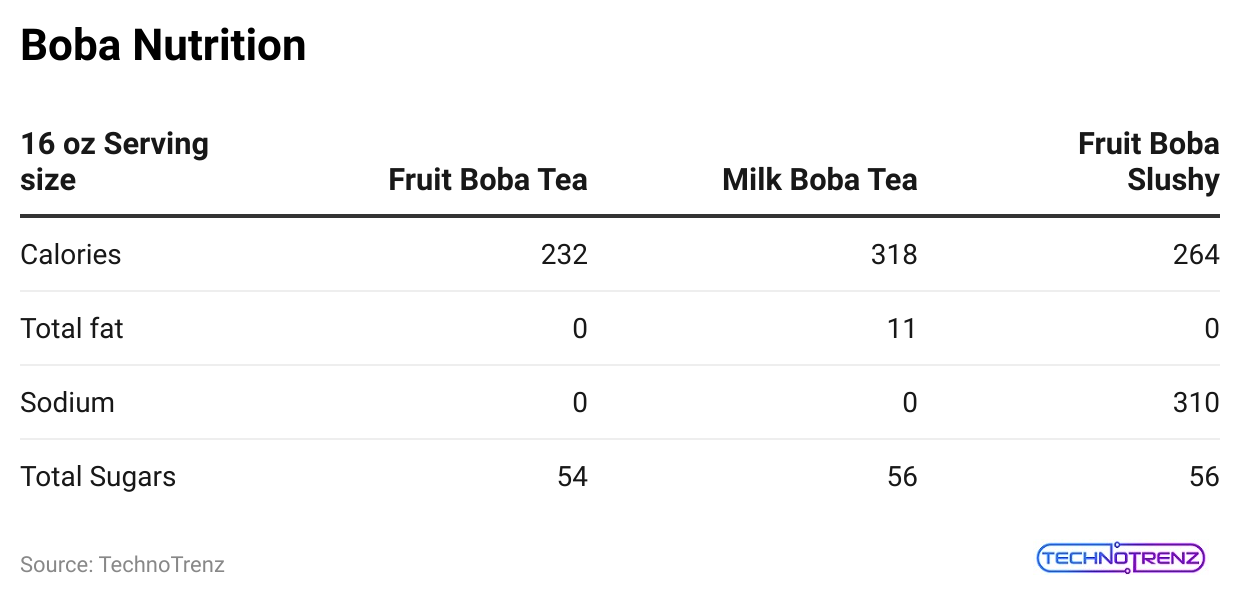
- For example, a 490 mL (16.5-ounce) serving of brown sugar bubble tea with tapioca pearls contains:
#1. Calories: 270
#2. Carbs: 45 grams
#3. Protein: 6 grams
#4. Fiber: 0 grams
#5. Fat: 7 grams
- The protein mainly comes from milk powder, while some of the fat and calories come from non-dairy creamer, which also has carbs.
- A large portion of the carbs and calories in this drink comes from the brown sugar that adds sweetness.
- This drink provides about 15% of the daily value (DV) for calcium and 7% for potassium, but it also contains around 9% of the DV for sodium, which is about 211 mg of salt.
- In general, bubble tea is best enjoyed as a sweet treat.
- There’s no strong evidence that it offers health benefits, but it’s a fun drink with its sweet flavors and chewy tapioca pearls!
Recent Development In The Bubble Tea Market
- In January 2023, Gong Cha, which originated in Taiwan, celebrated a major milestone by opening its first store in Portugal. This expansion, managed by franchisee Amelle Morisot, shows Gong Cha’s ongoing growth in Europe since it first entered the market in 2019.
- In January 2024, the MIXUE Group, a well-known Chinese bubble tea and beverage company, revealed plans to raise nearly $1 billion through an upcoming IPO in Hong Kong. The funds will be used to improve its operations and support future growth.
- In April 2022, a New York-based start-up called BUBLUV, Inc. introduced its BUBLUV Bubble Tea, a Ready-To-Drink (RTD) option that has fewer than 50 calories per bottle and contains no added sugar or artificial ingredients. This healthier choice is designed for health-conscious consumers looking for a guilt-free bubble tea experience.
- In February 2024, Gong Cha, a leading bubble tea chain, announced a partnership with the European franchisee Mad Vision Group to open 15 new stores in a North African country. This expansion aims to capitalize on the rising popularity of bubble tea in the region.
How is Bubble Tea Made?
- Bubble tea comes in 250 different flavors. Whether you want something sweet, fruity, or smooth, there’s a flavor for everyone! If you’re feeling adventurous, try as many flavors as you can to find your favorite.
- According to Bubble Tea Popularity Statistics, there are six main types of bubble tea: milk tea, black tea, fresh fruit tea, smoothies, fresh milk, and salted cream.
- A 16-oz serving of bubble tea contains about 38 grams of sugar, which is 76% of the recommended daily intake. Because bubble tea is very sweet, it’s best to enjoy it in moderation.
- The chewy tapioca balls, or pearls, are made from cassava flour. Nigeria is the world’s largest exporter of cassava, accounting for 21% of the global supply.
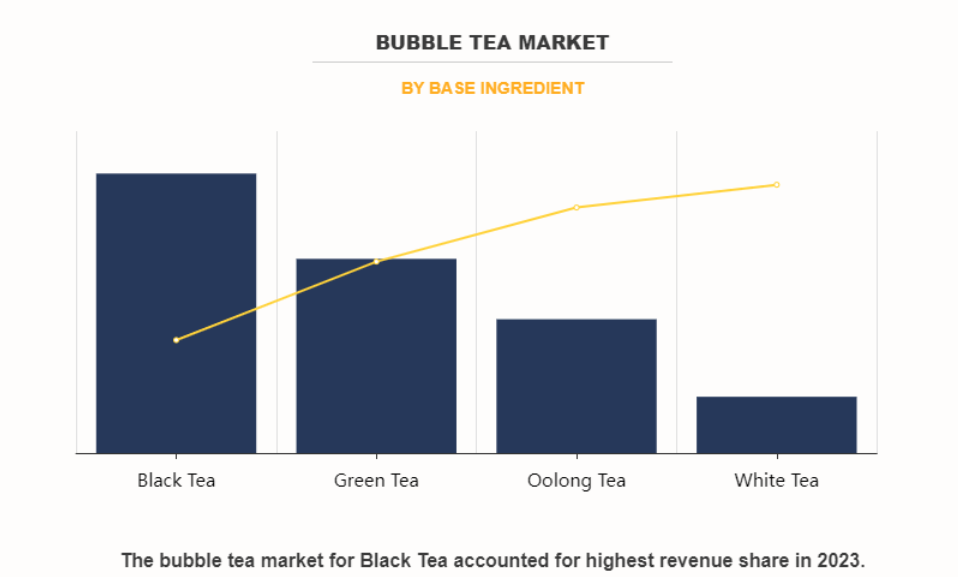
(Source: alliedmarketresearch.com)
- A medium-sized serving of bubble tea has around 335 calories. With larger sizes or extra toppings, this number can increase to 469 calories.
- Many, especially younger people, enjoy bubble tea. 94% of people aged 20 to 29 have bought bubble tea in the last three months.
- In the United States, 95% of women have tried bubble tea, compared to 81% of men. The drink is often seen as more popular among women.
- Bubble tea is available in over 30 countries, with Thailand leading in consumption at an average of 6 cups per person per day.
- The bubble tea industry was valued at $2.2 billion in 2019 and is expected to reach $3.39 billion by 2027, showing significant growth potential.
Consumer Preferences And Trends Of Bubble Tea
- Bubble Tea Popularity Statistics show that Fruit-based bubble tea flavors are the most popular, accounting for over 50% of the market.
- The popularity of bubble tea is rising among younger people, which is helping the market grow.
- North America is seeing an increase in bubble tea drinking, with more specialty bubble tea shops opening.
- There’s a demand for customizable and healthier bubble tea options, leading to new ideas in the industry.
- Bubble tea is becoming more popular on social media, attracting younger customers.
- Online ordering and delivery services have made bubble tea easier to get.
- A regular-sized bubble tea usually costs between $3 and $5.
- About 85% of bubble tea drinkers prefer to buy their drinks in person at shops rather than online.
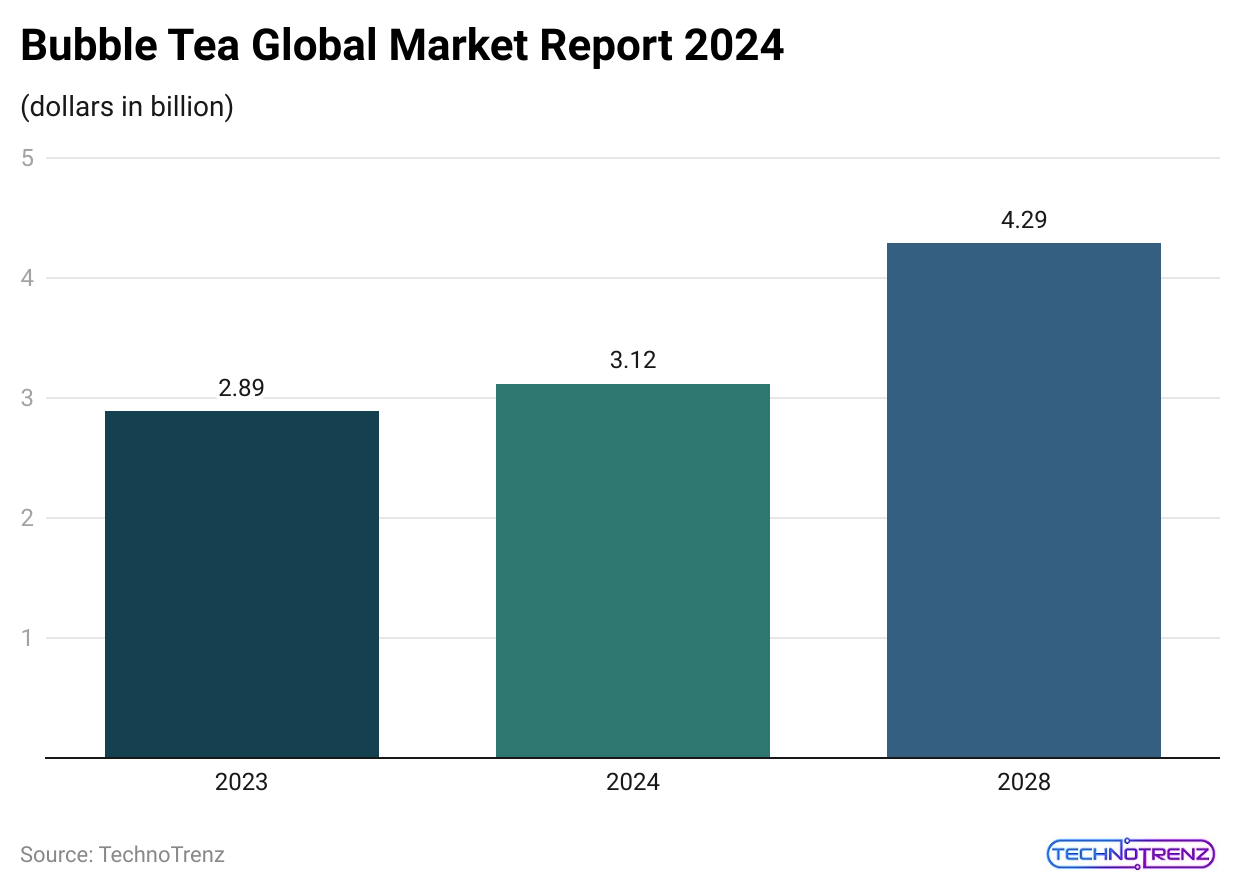
(Reference: blog.tbrc.info)
- Milk-based bubble tea flavors are becoming more popular, especially among Western customers.
- The market for vegan bubble tea options is growing to meet the demand for plant-based choices.
- The name “bubble tea” comes from the frothy bubbles that form when the tea is shaken or mixed with milk or fruit.
- Bubble tea is also known as boba tea, pearl milk tea, or tapioca tea.
- The pandemic has led to a rise in DIY bubble tea kits and recipes for making it at home.
- According to Bubble Tea Popularity Statistics, bubble tea is often served with a wide straw so that the tapioca pearls and toppings can be sipped easily.
- Some shops offer reusable or eco-friendly straws as part of their efforts to be sustainable.
- There has been a rise in artisanal bubble tea shops that focus on using high-quality ingredients and unique flavors.
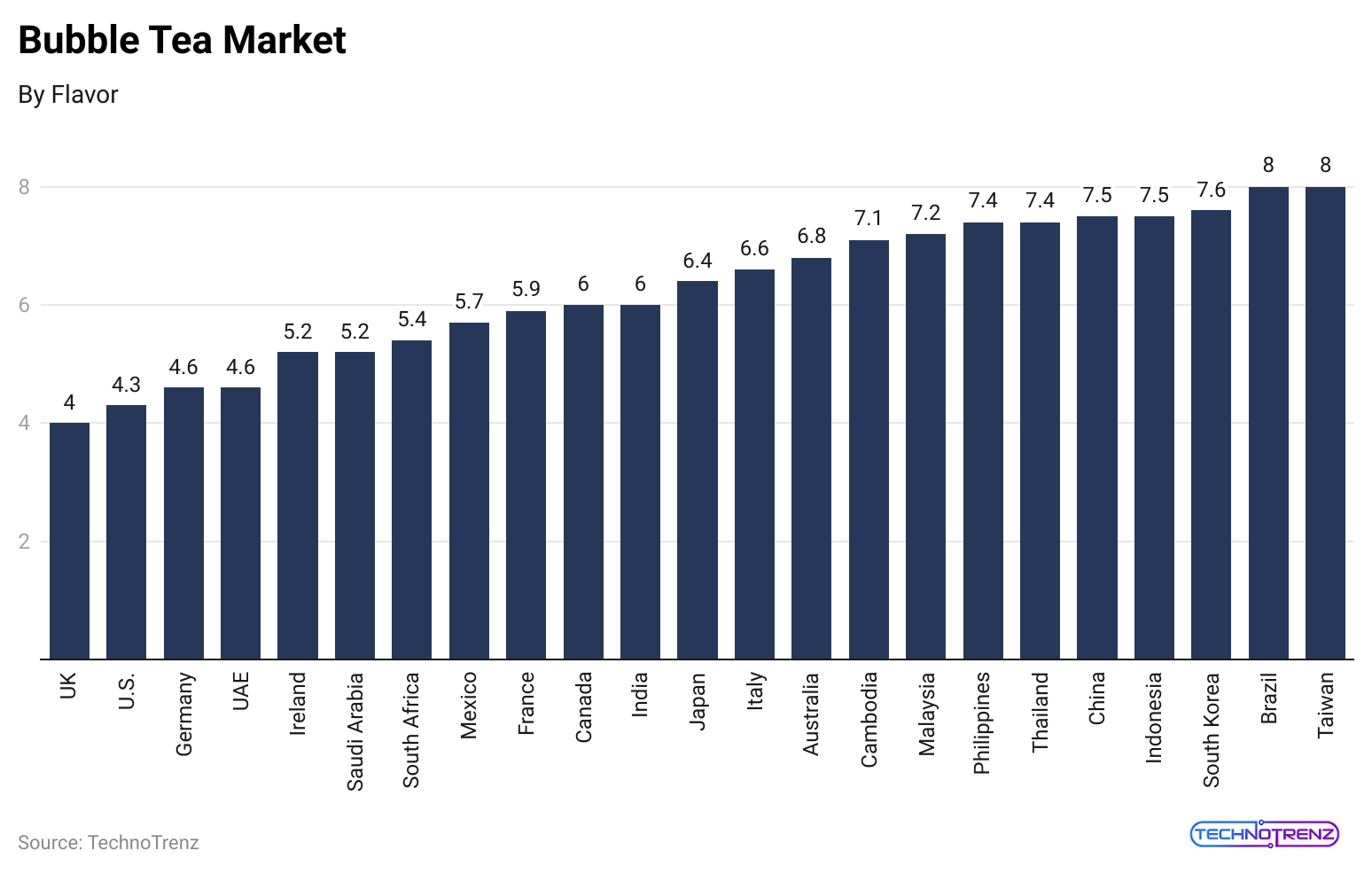
(Reference: alliedmarketresearch.com)
- Social media influencers and food bloggers have helped spread the popularity of bubble tea around the world.
- The demand for sugar-free bubble tea options is increasing, driven by health-conscious consumers.
- Bubble tea is often enjoyed as a dessert or treat, and it comes in a wide range of flavors and toppings.
- The industry is focusing more on sustainable packaging and environmentally friendly practices.
- The popularity of bubble tea has led to the creation of themed merchandise and accessories.
- Bubble tea has evolved to include unique flavors like matcha and taro.
- People of all ages enjoy bubble tea, from kids to adults, as per Bubble Tea Popularity Statistics.
- The trend of customization allows customers to choose their sweetness levels, toppings, and tea bases.
- The bubble tea trend has inspired bubble tea-flavored desserts, snacks, and even cocktails in restaurants and cafes around the world.
Emerging Market and Trends
- The global bubble tea market is expected to grow at a compound annual growth rate (CAGR) of 8.4% from 2021 to 2028.
- The market for vegan bubble tea is increasing quickly, offering many plant-based milk options.
- In South Korea, the bubble tea market is expanding fast, driven by rising demand from young consumers.
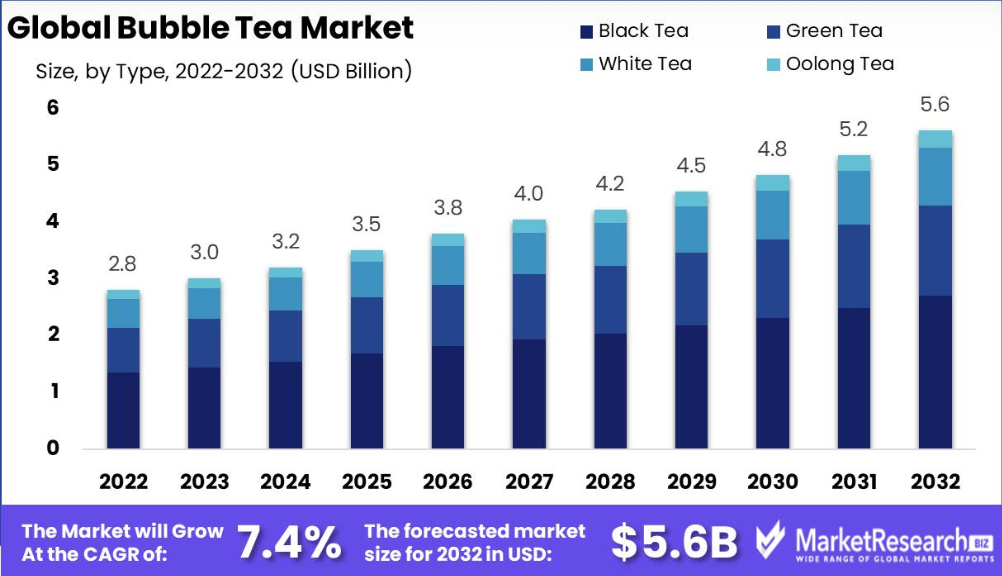
(Source: marketresearch.biz)
- The worldwide market for fresh bubble tea is growing, with more emphasis on quality ingredients.
- The popularity of Asian food and drinks is boosting the global bubble tea market.
- The Philippines is experiencing a bubble tea boom, with more shops opening throughout the country.
- The global bubble tea market is also projected to grow at a CAGR of 7.2% from 2021 to 2027.
- Indonesia has a rapidly growing bubble tea market featuring a wide range of unique flavors and toppings.
- In Japan, the bubble tea market is steadily growing, focusing on health-conscious and premium tea options.
- According to Bubble Tea Popularity Statistics, the global market for organic bubble tea is expanding, driven by consumer demand for healthier choices.
- In Canada, the bubble tea market is growing, emphasizing innovative flavors and high-quality ingredients.
Bubble Tea Regional Insight
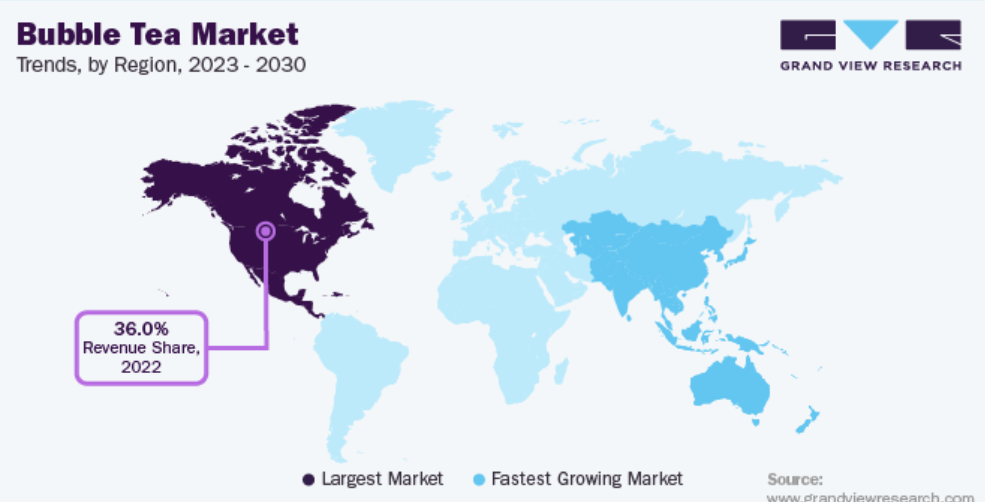
(Source: grandviewresearch.com)
- In 2023, North America was the top region in the bubble tea market, accounting for more than 36.00% of total revenue.
- This high percentage is due to the strong demand for fruity tea drinks. Recently, the number of bubble tea shops in the US has grown significantly.
(Reference: precedenceresearch.com)
- The Asia Pacific region is projected to have the fastest growth from 2023 to 2030, thanks to an increasing interest in healthy hot beverages. Bubble tea was first created in Taiwan.
- Thailand is one of the biggest consumers; according to the ASEAN Post, each person in the country consumed an average of six cups of bubble tea each month as of December 2023. Social media influencers and users boost the demand for bubble tea in this area.
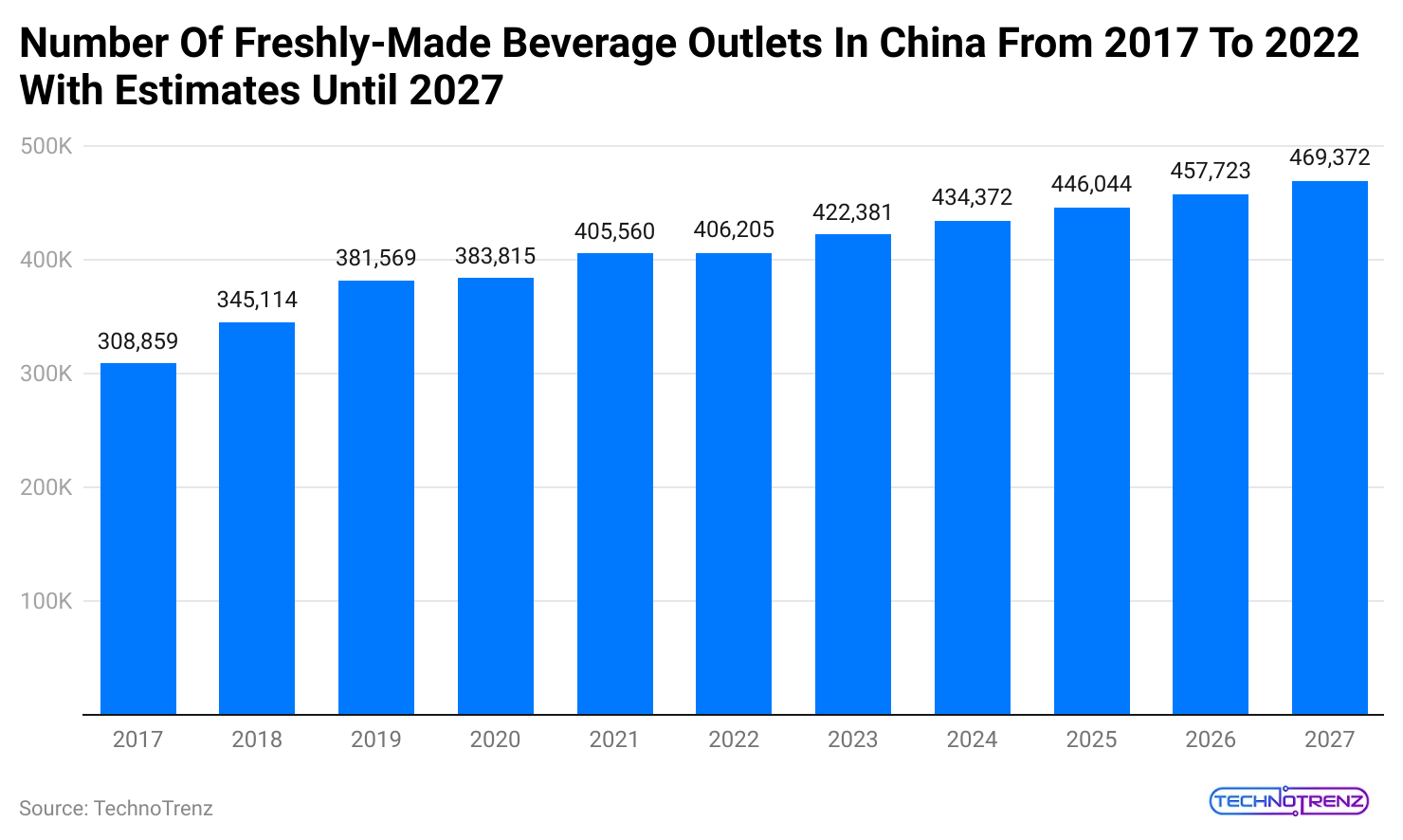
(Reference: statista.com)
- Bubble tea, also called milk tea, originated in Taiwan in the 1980s and quickly became popular worldwide.
- This sweet drink often includes milk, juice, and chewy tapioca pearls. The bubble tea trend started in 2000.
- Bubble tea has been very successful in China in the last ten years, with sales exceeding $10 billion annually.
- As of 2022, there were more than 400,000 bubble tea shops across the country, mostly run as franchises.
- Thanks to the internet, bubble tea sales in China nearly doubled in less than five years.
- According to Bubble Tea Popularity Statistics, customers pay over 20 yuan (about $3) for a cup, which is similar to the cost of a simple meal.
- This popularity has attracted billions of dollars to the industry. In just 2019, over 20,000 new bubble tea businesses opened in China.
- By February 2023, 14 new tea companies had launched more than 1,000 stores, with Mixue Ice Cream & Tea leading the way with 23,487 outlets.
- After Nayuki went public in 2020, six other companies also filed for IPOs in 2023.
- Despite the excitement, the crowded market has led to lower profits for many businesses.
- While the industry’s outlook remains positive in the coming years, experts believe it will become more concentrated, putting many smaller businesses at risk of closing, as per Bubble Tea Popularity Statistics.
- The bubble tea market in China has changed a lot compared to twenty years ago.
- Franchise chains have mostly replaced independent shops, and fresh juice and milk are now used instead of concentrated syrup and powdered milk.
- However, bubble tea faces criticism for being a health risk, especially for kids and young adults.
- A survey in 2023 showed that nearly two-thirds of Chinese people drink bubble tea at least three times a month, and about a quarter consume it more than once a week.
- Studies indicate that drinking too much bubble tea can lead to obesity, heart disease, diabetes, and even mental health problems.
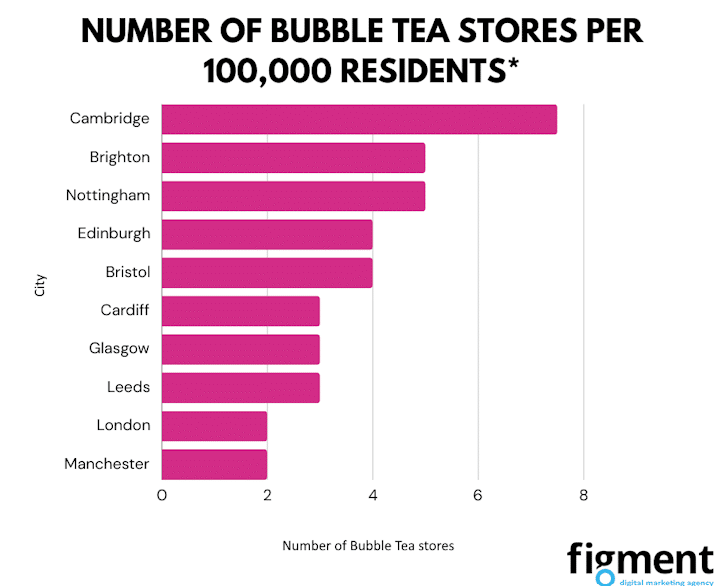
(Source: figmentagency.com)
- With 3.7 million Instagram posts and 1,481 bubble tea shops, the UK bubble tea market is projected to grow by 225% over the next ten years. Bubble tea has become a favorite drink in Britain.
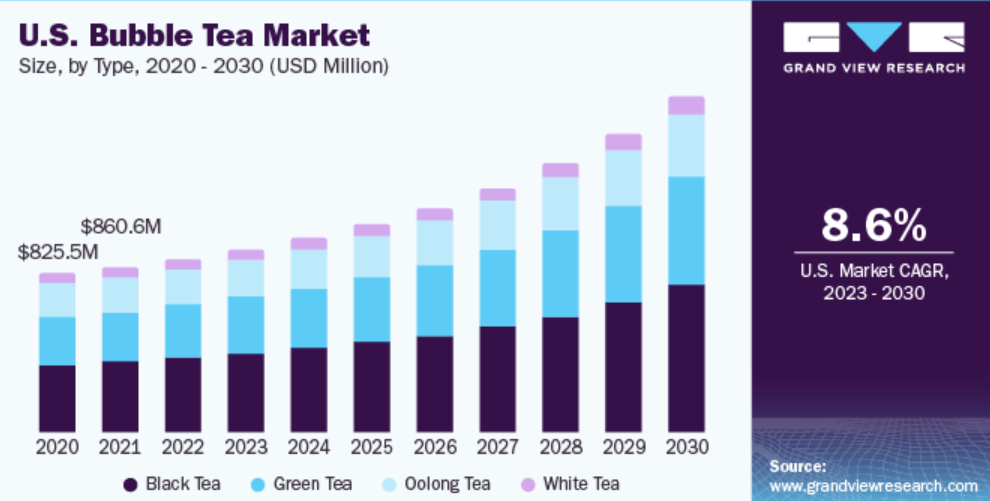
(Source: grandviewresearch.com)
- The US bubble tea market is projected to grow at a rate of 7.3% each year from 2021 to 2027.
- The U.S. is the largest buyer of tapioca pearls, which are a key ingredient in bubble tea.
- Most bubble tea drinkers in the US are between 18 and 30 years old. The highest consumption of bubble tea is found in cities with diverse populations.
- A typical cup of bubble tea costs between $4 and $7.
- The US imports over 9 million kilograms of tapioca pearls every year for this market.
- Bubble Tea Popularity Statistics stated that the demand for vegan and dairy-free bubble tea options has increased by 30% in the past year.
- Due to the COVID-19 pandemic, online ordering and delivery services for bubble tea have gone up by 40%.
- Among Gen Z consumers, the popularity of bubble tea has risen by 35% in the last year.
- In Malaysia, bubble tea sales have jumped by 50%, with taro flavor being the top choice.
- In Germany, bubble tea sales have grown by 30% in areas with many students.
Segmentation Analysis Statistics
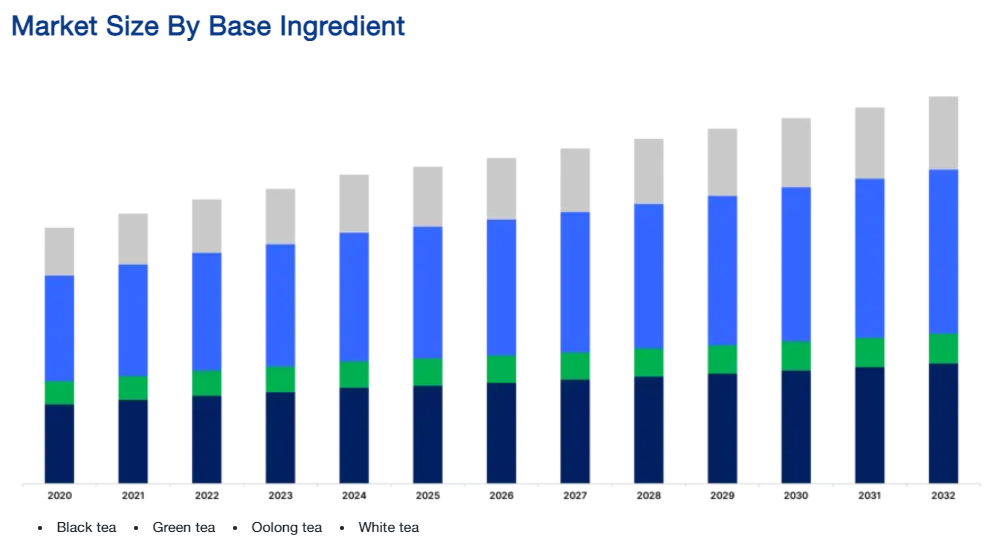
(Source: straitsresearch.com)
- The global bubble tea market is divided into different base ingredients: black tea, green tea, oolong tea, and white tea.
- Black tea is the most popular and is expected to grow at a rate of 7.7% each year during the forecast period.
- It contains antioxidants that help remove harmful substances from the body, which may lower the risk of chronic diseases like heart disease, diabetes, obesity, and cancer. These health benefits are helping the bubble tea market expand.
- Green tea is the second most popular base, as per Bubble Tea Popularity Statistics.
- Many health-focused consumers prefer bubble tea made with green tea because it boosts physical performance and aids fat burning.
- Green tea also has antibacterial properties that improve oral health and lower the risk of infections, increasing demand for this type of bubble tea.
- Oolong tea ranks third among base ingredients. It is partially fermented and mostly produced in certain regions of China, including Fujian and Guangdong provinces and Taiwan.
- Oolong tea has characteristics of both green and black tea and offers several health benefits, such as antioxidant effects, reducing inflammation, and preventing heart disease. This makes it popular among health-conscious drinkers.
- The bubble tea market is also categorized by flavor: original, coffee, fruit, chocolate, and others.
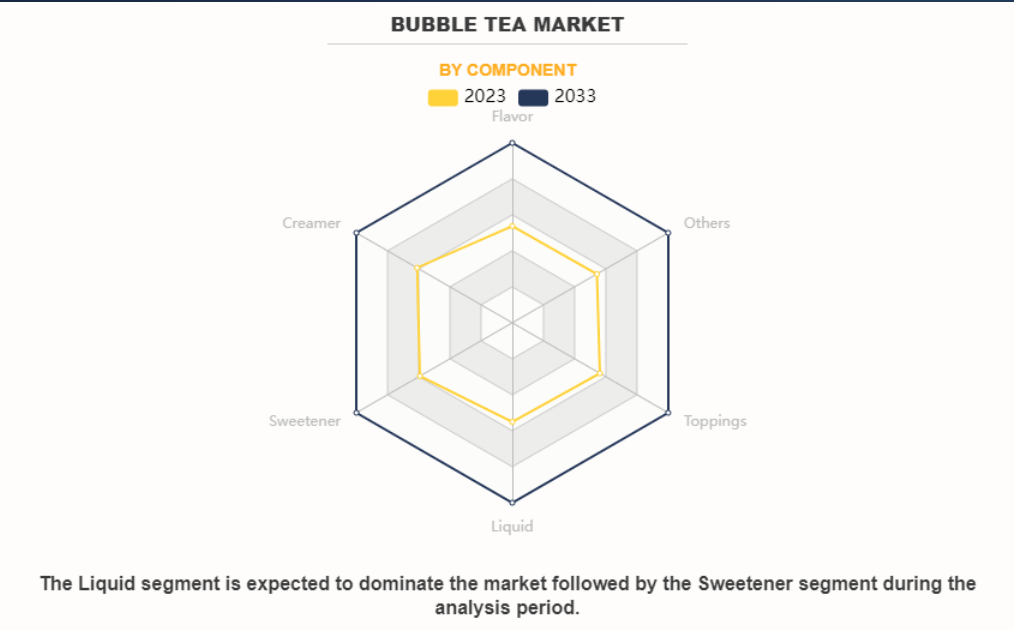
(Source: alliedmarketresearch.com)
- The fruit flavor segment is the largest and is expected to grow by 8.2% each year.
- Popular fruit flavors include avocado, banana, and watermelon. These options attract health-focused and vegan consumers, driving the market growth.
- Chocolate flavor is the second largest category. It appeals to people of all ages and is known for reducing stress and benefiting heart health, which is increasing demand for chocolate-flavored bubble tea.
- According to Bubble Tea Popularity Statistics, the market includes flavor, creamer, sweetener, liquid, tapioca pearls, and others as components.
- The liquid segment is the largest, with an expected growth rate of 8.5% annually. Young and health-conscious consumers are eager to try new flavors, like black tea, green tea, and fruit juice, which boosts the market growth.
- The sweetener segment is the second largest. Common sweeteners include white or brown sugar, fructose, and honey. There is a growing preference for natural sweeteners like honey over artificial ones, which can have negative health effects.
- The creamer segment is the third largest, as per Bubble Tea Popularity Statistics.
- Creamers can be dairy or non-dairy and are used to thicken bubble tea.
- Popular options include vegan and pumpkin creamers. The demand for thick iced tea is increasing, especially in the Asia-Pacific and LAMEA regions, contributing to the market’s growth.
Consumer Demographics Statistics
- Allied Market Research says the global bubble tea market is expected to reach $3.2 billion by 2023.
- The United States is one of the fastest-growing markets for bubble tea, with a projected growth rate of over 7% from 2019 to 2026.
- Recent studies show that bubble tea is particularly popular among younger people.
- Most bubble tea drinkers are between 18 and 30 years old, and more teenagers are getting into it, attracted by the trendy vibe and social media presence of bubble tea shops.
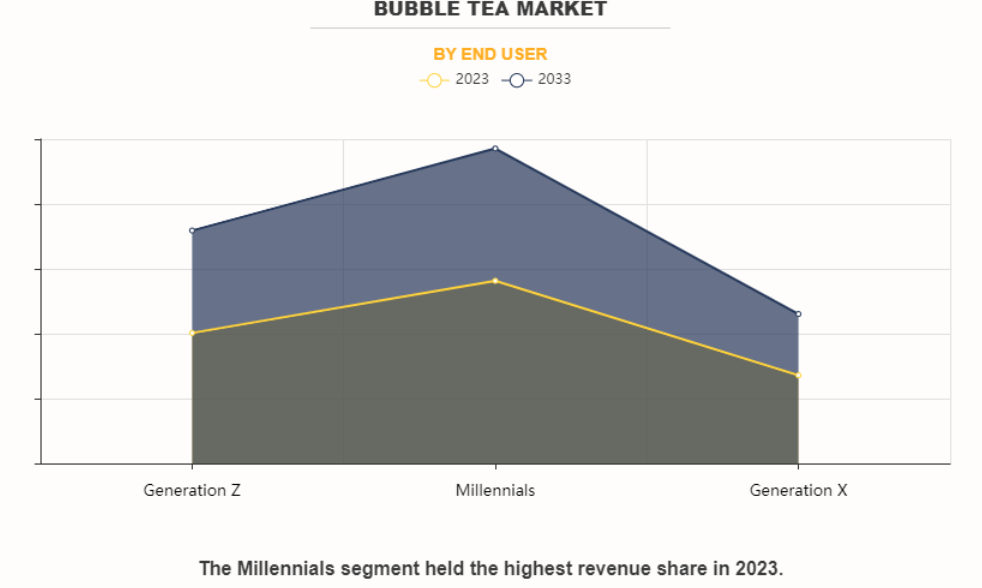
(Source: alliedmarketresearch.com)
Gender Trends
- Both men and women enjoy bubble tea, but research indicates that women tend to drink it more regularly than men.
Ethnicity And Cultural Background
- Certain ethnic groups are more likely to enjoy bubble tea.
- Asian Americans are the largest group of bubble tea drinkers, followed by Hispanic/Latinx Americans and African Americans.
- This makes sense since bubble tea originated in Taiwan and is tied to East Asian culture. However, it is becoming more popular among diverse communities, too.
Education And Income
- A study by Mintel found that 38% of bubble tea drinkers have a bachelor’s degree or higher, which is more than the national average of 33%.
- Additionally, 29% of bubble tea consumers earn $75,000 or more annually, compared to just 20% of non-drinkers.
- This suggests a strong link between education, income, and bubble tea drinking, which could help businesses target their advertising.
Geographic Location
- Bubble tea has gained popularity, especially among young adults.
- Most drinkers are in Asia, particularly Taiwan and China, which produce and consume the most bubble tea.
- However, demand has also increased in North America and Europe.
- In the US, cities like New York and Los Angeles are hotspots due to their large Asian communities.
- Coastal states like California and New York also have more bubble tea drinkers because they are near these cultures.
- Urban areas tend to have more bubble tea fans than rural areas, as cities usually have more diverse populations and trendy options.
Factors Affecting Consumption
Several factors influence how much bubble tea people drink:
- Age: Younger generations are generally more willing to try new things, including different kinds of bubble tea. Gender can also affect what flavors are popular.
- Location: Bubble tea shops in cities or near colleges tend to sell more because they attract younger customers looking for trendy drinks. The availability of other beverages like coffee or smoothies can also impact bubble tea sales.
- Pricing: The price of bubble tea can be a barrier for some consumers. The cost often reflects the high-quality ingredients used, like premium teas, fresh fruits, and natural sweeteners, which can make a cup of bubble tea more expensive.
Conclusion
Bubble tea has become very popular around the world, especially among younger people. Its unique flavors, ability to customize, and fun chewy texture make it a favorite choice. The drink’s strong presence on social media has also helped it grow, attracting a wide range of customers.
As bubble tea continues to evolve with new flavors and styles, its popularity is expected to increase. The bubble tea market is set to grow due to a focus on healthier ingredients and creative combinations. Whether enjoyed in trendy cafes or made at home, bubble tea has become a loved drink globally. In this article, we have shed enough light on bubble tea popularity statistics.
Sources
FAQ.
The drink industry has seen more young people wanting premium beverages, and boba tea is becoming a popular option in this area. According to Bloomberg on June 24, a recent survey by CLSA found that 94% of individuals aged 20 to 29 bought boba tea in the last three months.
Bubble tea began in T’ai-nan, Taiwan, in the mid-1980s. Since then, many different kinds of this drink have been created, especially in Taiwan and other East Asian countries like Singapore, Hong Kong, and Japan. Popular flavours include taro tea, brown sugar tea, and matcha green tea.
To be clear, bubble tea and boba tea are two names for the same drink. Some people might use one name more than the other based on where they live or their personal choice, but there are no real differences between bubble tea and boba.
The bubble tea trend is really interesting and driven by several main reasons. One big factor is how customisable it is. People love being able to pick their flavours and toppings, making each drink feel special and just right for them.
Another reason for its popularity is how good it looks. The colourful drinks, often topped with bright things like tapioca pearls and fruit jellies, are very eye-catching. This makes them popular on social media, where people love to share photos. Cultural influences also play a part. As more international foods become available, many folks enjoy trying new things, and bubble tea offers a fun, exotic choice. Finally, there’s a social side to bubble tea. Whether it’s hanging out with friends at a shop or trying different flavours together, drinking bubble tea is a fun experience to share. All these factors come together to make bubble tea a big hit that keeps growing in popularity.

Saisuman is a professional content writer specializing in health, law, and space-related articles. Her experience includes designing featured articles for websites and newsletters, as well as conducting detailed research for medical professionals and researchers. Passionate about languages since childhood, Saisuman can read, write, and speak in five different languages. Her love for languages and reading inspired her to pursue a career in writing. Saisuman holds a Master's in Business Administration with a focus on Human Resources and has worked in a Human Resources firm for a year. She was previously associated with a French international company. In addition to writing, Saisuman enjoys traveling and singing classical songs in her leisure time.


